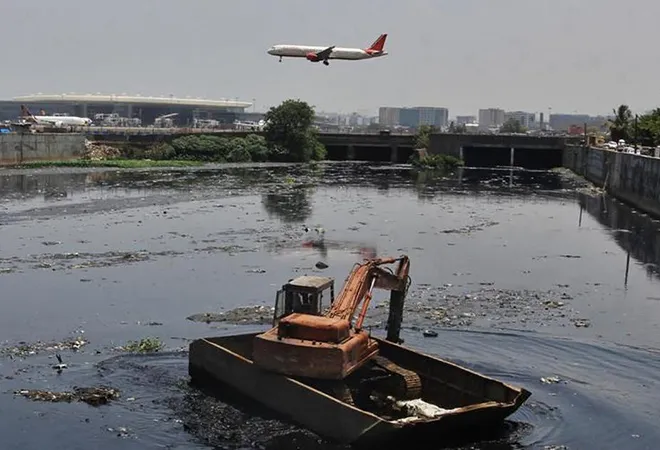
The unpredictability of the monsoon as a result of climate change leading to increased frequency of localised heavy rainfall in short spurts, causes urban flooding, and in turn loss of lives and livelihood. With an unfailing regularity, cities like Mumbai, Kolkatta, Delhi, Bhubaneshwar, Thiruvananthapuram and Bangalore get inundated for a few days at least during the monsoon, paralysing life and even leading to loss of lives.
A report put out by the Ministry of Earth Sciences (MOES), Government of India in June 2020, on ‘
Assessment of Climate Change over the Indian Region’ has categorically put out how these ‘increased frequencies of heavy rainfall on sub-daily and daily timescales has enhanced flood risk all over India’. It has gone on to note that this ‘increased frequency and impact of floods in on a rise in urban areas’.
A 2019 study of the South-West monsoon season depicted this unpredictability. It showed that on an average in June, India was almost 33 percent rainfall deficient. By July, the average showed that it was 4.6 percent more and by August 2019, this figure was in excess of the average by 35 percent. This means we have fewer rainy days and increased precipitation, leading to heavy rainfall in few hours, putting pressure on the existing urban drainage systems which have not been designed, neither augmented, to handle such extremes.
The drain systems in cities are outdated, and have followed guidelines prescribed in the ‘
Manual on Sewerage and Sewerage Treatment’ put together by the Central Public Health and Environmental Engineering Organisation (CPHEEO). According to the CPHEEO’s guidelines, storm drains were designed for rainfall intensity of 12–20 mm per hour, which is hugely undersized for the current rainfall standards. To fix this, in 2019, the Ministry of Housing and Urban Affairs (MOHUA) have released a ‘
Draft Manual on Storm Water Drainage Systems’, the latest drain design practices, which have to be followed and incorporated by state governments, and in turn, urban local bodies, in either replacing or retrofitting, and operation and maintenance of systems. It also puts out suggestions for budgeting and financing drainage projects. However, this is yet to be implemented, and is only suggestive in nature.
In 2018-19, the Indian Institute of Technology (IIT) Bombay carried out a
study of heavy rainfall days in 33 state capitals and Union Territories of India. Each city had witnessed rainfall of over 50 mm per hour, a trend which corresponded with floods on the same days in those cities. The study saw that Bhubaneswar, the capital of Orissa, on the east coast of India, received rainfall greater than 50 mm per day, 11 times during 2018-2019 and greater than 100 mm per day, six times during the monsoon. On 20 August 2018, Bhubaneshwar saw 190 mm per day of rainfall. Meanwhile, Kolkata witnessed rain of more than 50 mm per day 10 times, and more than 100 mm per day, three times during the season. On 25 June 2018, Kolkata saw 160 mm rainfall. Meanwhile Mumbai, which has been witnessing heavy short downpours, saw 50 mm per day rainfall, 12 times the normal and 100 mm per day, 9 times the normal during the 2018 monsoon. The city recorded a whopping 230 mm rain day on 24 June 2018. It is clear from these figures, that unless the drain capacities are increased, the flooding situation will not improve.
Other than the resizing of storm water drains which should be taken up on priority, there are several lacunae these cities suffer from. These deficiencies have led to the collapse of storm water drain infrastructure, made worse owing to poor or total lack of its operation and maintenance. Let us look at each of these issues with possible solutions to fix them:
1) Lack of data or maps of underground drains: Very often municipal bodies are unaware of the underground and over ground storm water drain network since there is no consistent mapping exercise that takes place. In many cities like Mumbai and Kolkata there are underground pipes which are over a 100 years old. All urban local bodies need to do contour mapping of cities and drain mapping along with that which will tell them the existing situation of drains along with the new ones that need to be laid according to land contours to determine the natural flow of water.
2) Setting up operation and maintenance systems: After the 2005 deluge of Mumbai, the civic body took up the works of upgrading drains on a war footing through its Brihanmumbai Storm Water Drain (BRIMSTOWAD) upgradation project. It has been 15-years and
only 70 percent of the INR 20 billion project is complete. In addition, desilting works that clear nullahs and drains of plastic and garbage before every monsoon are very often done shoddily. Both the state and central governments need to implement the MOHUA manual which lays down protocols for such works.
3) Unconnected informal areas: The informal areas and encroached settlements in cities are not connected through the storm water drain networks and very often the rain water gets mixed up with sewage and garbage causing huge bottlenecks in the existing system. A consistent effort needs to be carried out either to prevent such areas from mushrooming or create networks connecting them.
4) Lack of funds: There is very little money available for upgradation of storm water drains, since most of the expenses are diverted towards operation and maintenance. While there are funds allocated for this through the AMRUT scheme, which must be used, the
MOHUA has encouraged cities to explore tapping private funds through public private partnerships (PPP) for this purpose. It has also suggested that state governments must come up with a user fee where citizens pay for the maintenance of storm water drains. Another proposition made is to consider green infrastructure retrofit financing for stormwater drains. It gives the example of Chester, USA, where they have used a Community-Based Public-Private Partnership (CBP3) to plan, finance, build and maintain up to $50 million in green stormwater infrastructure. This will take place over the next 20- 30 years on approximately 350 acres to address significant pollution and flooding issues in Chester.
If cities do not take urgent steps to bring in corrective measures, the situation is bound to get compounded and India which already
ranks fifth on the climate change risk index will slip further.
The views expressed above belong to the author(s). ORF research and analyses now available on Telegram! Click here to access our curated content — blogs, longforms and interviews.



 The unpredictability of the monsoon as a result of climate change leading to increased frequency of localised heavy rainfall in short spurts, causes urban flooding, and in turn loss of lives and livelihood. With an unfailing regularity, cities like Mumbai, Kolkatta, Delhi, Bhubaneshwar, Thiruvananthapuram and Bangalore get inundated for a few days at least during the monsoon, paralysing life and even leading to loss of lives.
A report put out by the Ministry of Earth Sciences (MOES), Government of India in June 2020, on ‘
The unpredictability of the monsoon as a result of climate change leading to increased frequency of localised heavy rainfall in short spurts, causes urban flooding, and in turn loss of lives and livelihood. With an unfailing regularity, cities like Mumbai, Kolkatta, Delhi, Bhubaneshwar, Thiruvananthapuram and Bangalore get inundated for a few days at least during the monsoon, paralysing life and even leading to loss of lives.
A report put out by the Ministry of Earth Sciences (MOES), Government of India in June 2020, on ‘ PREV
PREV


